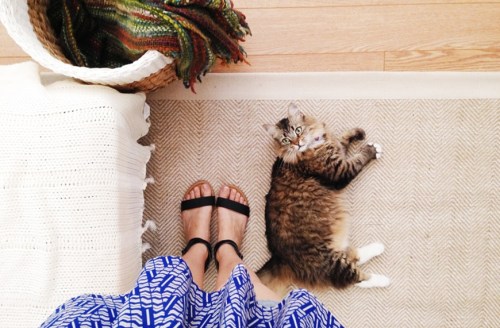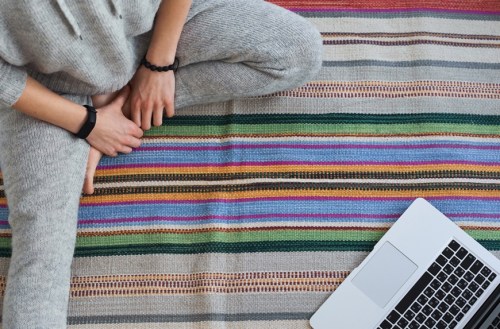In preparation for a move into my *dream* apartment, I recently spent nearly three months looking for the perfect rugs to go in my bedroom and living room. I wanted pieces that would instantly add color, fun patterns, and warmth to a small space. After way too much shopping, I decided on a high-pile Moroccan rug and an olive jute number.
But the one thing I should have considered—as carefully as square footage and budget—was how much the rugs would shed. It never even crossed my mind but as it turns out, no matter how much I sweep or vacuum, there’s fuzz aplenty. Fuzz on my leggings. Fuzz in the corners of the room. It’s everywhere.
Hoping to reduce the shedding, I turned to a rug-care pro. Lisa Wagner, author of the Rug Chick blog and the co-owner of a San Diego-based rug-cleaning company, knows a thing or two about this (hairy) struggle.
Keep scrolling for her hard-earned advice.
The problem with rug shedding…
Not all rugs are created equal. While hand-knotted rugs made with 100-percent wool tend not to shed, they’re pricey. Constant shedding is much more common with synthetic fibers (such as acrylic, nylon, or viscose), which are weaker and more susceptible to the impact of foot traffic, which leads to lots and lots of shedding.
Here’s the dilemma: These synthetic materials are legit everywhere, making them hard to avoid―especially when you’re on a budget (I feel you). One popular synthetic option is viscose, also known as a dozen other things including artificial silk, bamboo silk, banana silk, rayon, and man-made silk.
“Viscose and all of its derivatives are the weakest fibers in the rug world today because they are chemically processed wood pulp and cotton waste byproducts, so they are essentially pressed paper,” Wagner says. “This means that of all of the fibers, these are the most likely to shed and have fiber pulls.”
Rugs that shed could also impact your sinuses, according to non-toxic living expert Debra Lynn Dadd. “The materials themselves can vaporize harmful gases, plus they are usually treated with toxic stain resistant chemicals and fire retardants,” Dadd says. To minimize exposure to toxic chemicals, she recommends buying rugs made with 100-percent natural materials that aren’t treated with synthetic dyes, fire retardants, or moth-proofing chemicals.

…And the solutions
Other than opting for a hand-crafted wool rug the next time around, there’s one method you can try to extend the lifespan of your viscose rug. “One tip to protect these rugs is to have fiber protector applied to them when brand-new,” Wagner says.
To combat fuzz, lightly vacuum the rug on a low setting, going with the grain of the pile to minimize damage. If possible, move the carpet to a low-traffic part of the house. You can also use a rug pad to help minimize the wear and tear.
Also avoid plant-fiber rugs like jute, sisal, and nettle. Rugs made from natural-plant fibers shed all the time—I know from experience. “These fibers do not have the longevity of wool, cotton, or real silk,” says Wagner. “These fibers splinter and fray in the process of creating braids, basket weaves, or large knots. In the most brittle qualities, the fibers become like straw and snap off into little pieces.”
But if you do end up with one of these rugs, here’s a *very* pro tip. “Use a horsehair brush to loosen up small pieces, and then follow up with a hand vacuum to help pick up the pieces,” Wagner says. And stay away from using upright vacuums with beater bars on jute, sisal, or nettle rugs.

Your new go-to fabric?
Wool is the all-star of the rug game. “A good-quality, standard-pile height, hand-knotted wool rug should not shed,” Wagner says. The wool used in hand-knotted rugs has to be sturdy enough to endure the manual twisting and knotting in the weaving process. (This is why rugs can sometimes be considered family heirlooms.)
Lower-quality wool (that’s not strong enough to use in hand-knotted rugs) is used to make hand-loomed and tufted rugs. The process involves the use of a hand-held drill gun, which punches yarn into place. “With these rugs, if you take your thumbnail and strongly scratch the front fibers, you can break them apart, and the texture of the wool is more scratchy than it is soft to the touch,” Wagner says. These rugs do better in a low-traffic areas. Use a vacuum on low without a brush or beater bar attachment to keep shedding under control.
Shaggy wool rugs will shed, even when they’re made with high-quality, all-natural wool. When wool is spun into long strands, they’re more likely to come loose, Wagner says. That explains the abundance of dust bunnies next to your Moroccan shag or Greek flokati rugs. A horsehair broom should help reduce shedding, or use a leaf blower to “blast away the dust and ‘stuff’ in the fibers,” says Wagner.
Rugs that shed are a double buzz kill: They create a fuzzy mess and could mess with your sinuses. But we do the best we can, and here are some all-natural cleaning products that can help.
Keep that clean lifestyle going: Discover an all-natural way to give your bedroom sheets new life and how to organize the spot we all forget about.
Sign Up for Our Daily Newsletter
Get all the latest in wellness, trends, food, fitness, beauty, and more delivered right to your inbox.
Got it, you've been added to our email list.










